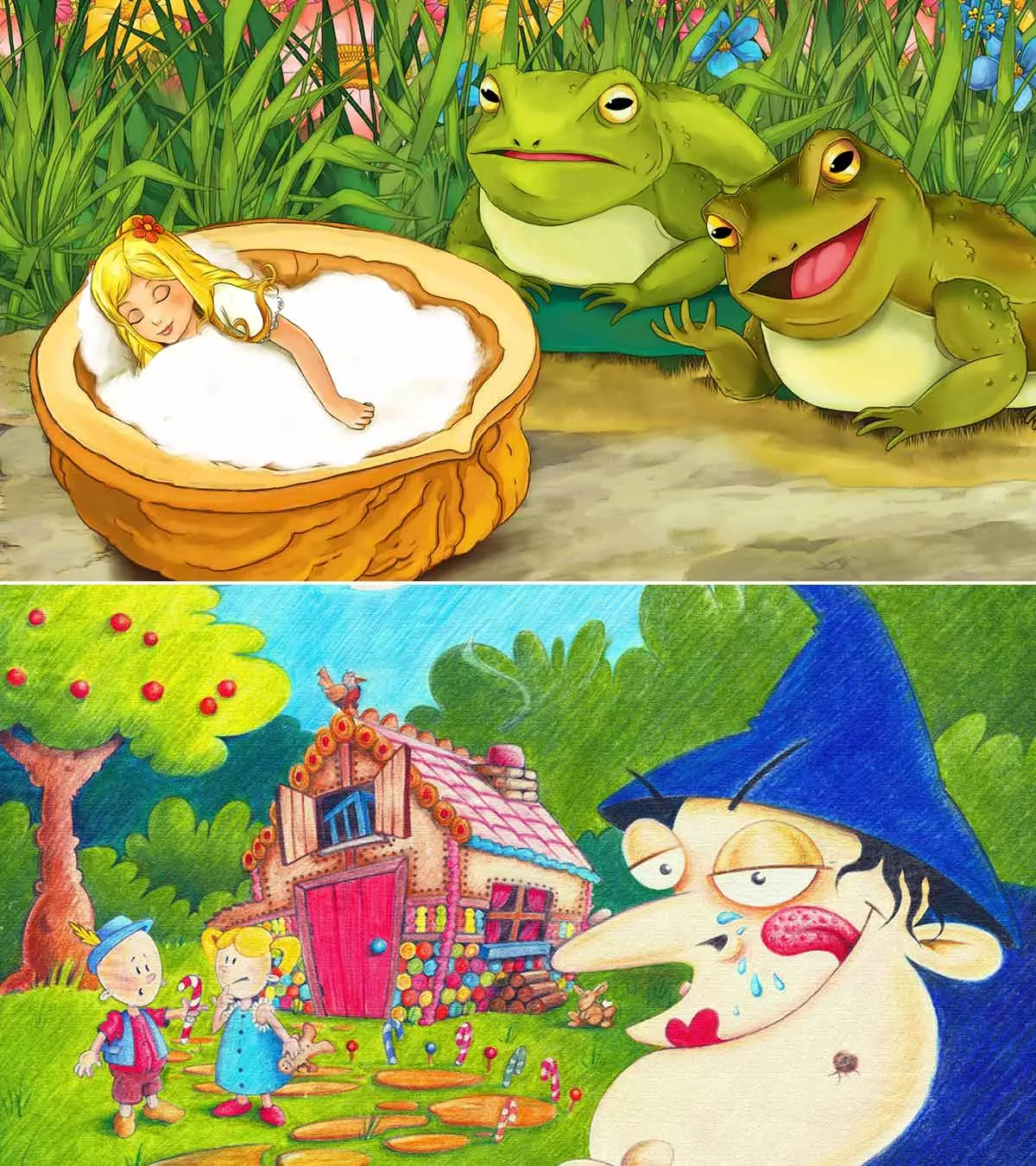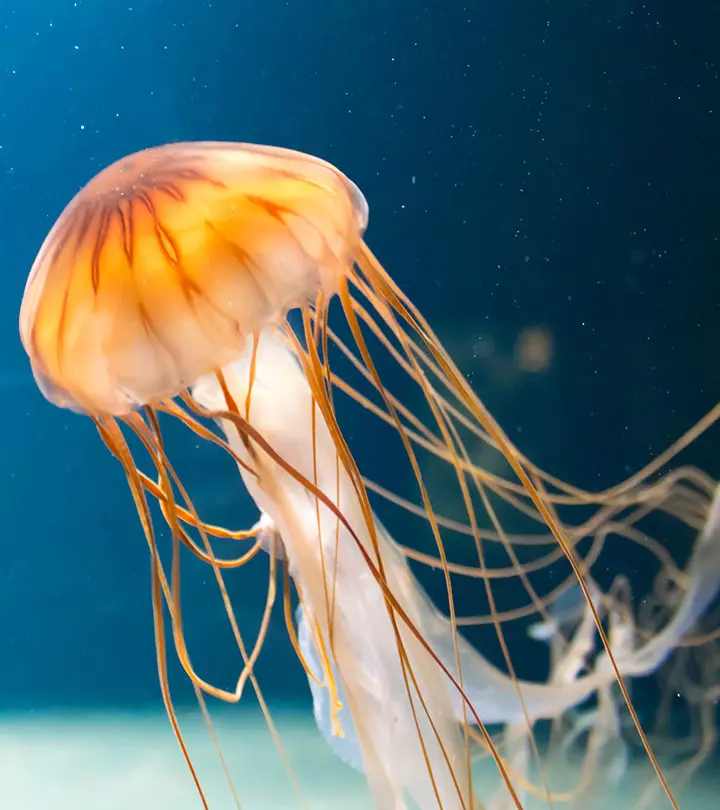
Image: ShutterStock
Facts about jellyfish for kids will surely delight them as they are one of the coolest and most beautiful sea creatures. This water creature is scary, but there is plenty of interesting information surrounding a jellyfish that makes it quite the exotic sea creature that it is. Long before dinosaurs, trees, or fungi existed, jellyfish roamed the Earth. As the oldest multi-organ animals, they have survived all five of Earth’s mass extinction events. Some studies even suggest that jellyfish may date back as far as 700 million years (1). It has lived for millions of years on this planet; therefore, its survival tactics are a matter of study among enthusiastic underwater biologists as well. To help your kids learn a few cool facts about a fascinating sea creature like jellyfish, we bring you a roundup of fun facts about jellyfish. Scroll down.
Key Pointers
- The jellyfish’s body is composed of 90% water and surrounded by two layers of cells that form the umbrella.
- A respiratory system or brain is absent in jellyfish, but they possess a nerve net that helps them sense changes in their environment.
- Jellyfish tentacles, filled with toxins, can be dangerous to humans.
- Jellyfish survive by capturing plankton and different marine creatures with their tentacles, which are filled with toxins capable of paralyzing their prey.
- Jellyfish can clone themselves and generate multiple offspring.
Information About Jellyfish For Kids
1. Scientific classification of jellyfish
The jellyfish are grouped under Cnidaria phylumiA taxonomic rank used to classify organisms with similar body plans, developmental patterns, and/or evolutionary histories , whose characteristic feature is the presence of a gelatinous and a non-living body embedded between the epithelial layers.
There are around 4,000 different types of jellyfish and scientists say that 3,000,000 different species of jellies are yet to be discovered.
2. Jellyfish are not actually fish
Yes, that’s right! Jellyfish are not fish. They are plankton from the phylum Cnidarian and Scyphozoan class. Most people consider the term a misnomer. The American public aquariums have given the term sea jellies or jellies instead.
3. The anatomy of a jellyfish
Jellyfish come in a diverse range of forms and colors like pink, white, yellow, orange, green, and blue. Some are even multi-colored. Jellyfish are composed of 90% water. Most of their body is a gelatinous material called mesoglea surrounded by two layers of cells that form the umbrella. The subumbrella of the body is called the bell.
Jellyfish do not have a respiratory system, as their skin is thin enough to oxygenate the body by diffusion. Neither do they have a central nervous system or brain. Rather, they have a loose network of nerves (nerve net) located in the epidermis. This nerve net helps them sense the changes in their environment and coordinate the marine animal’s responses, enabling them to sense touch, temperature, salinity, and more. Their brain, made up of about 10,000 neurons, is distributed throughout their entire body (2).
The mouth of the jellyfish is housed in a dome or bell-shaped central body area surrounded by tentacles. They discard and eat the waste from this mouth-like opening. They even squirt water from their mouth, which propels them forwards.
4. Jellyfish locomotion
The movement of jellyfish depends on the currents and tide of the water and wind. Some jellyfish are sensitive to light and move downwards during the daytime. Jellies also need water for survival. The absence of water can cause desiccation and these marine creatures can lose their life.
5. The deadly tentacles of jellyfish
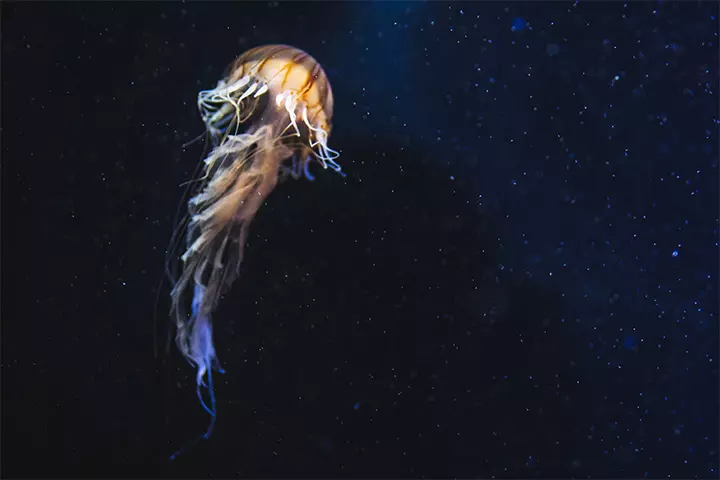
Jellyfish have stinging cells in the tentacles, which are filled with toxins. They stun or immobilize their prey before eating them. Jellyfish typically don’t attack humans. Most of the stings occur when humans accidentally touch a jellyfish. But, some species of jellyfish can be menacing for humans. Jellyfish washed ashore can also sting. Be very careful if you are investigating a specimen. A tentacle separated from its body can sting and carries enough venom to be a threat to life.
 Quick tip
Quick tip6. Jellyfish are dioecious
Jellyfish are dioecious. So a jellyfish colony will either be entirely female or male. And in most of cases, both male and female jellyfish release eggs and sperm into the surrounding water where the eggs fertilize and mature into new organisms.
7. The deadliest and the largest jellyfish
The box jellyfish is the deadliest animal in the animal kingdom. It has caused 5568 deaths since 1954. Each tentacle of the box jellyfish has around 500000 cnidocytes, harpoon-shaped needles that inject venom into the victim. The venom can lead to a 4 to 10-year-old child’s death within 3 minutes.
The Arctic Lion’s Mane is the largest species of the jellyfish. The Arctic Lion’s Mane jellyfish is one of the longest known marine animals. The diameter of the body of Arctic Lion’s Mane is 7 feet 6 inches. And the tentacles are around 120 feet long. An Arctic Lion’s Mane was found washed up on the Massachusetts Bay shore in 1870.
8. The humongous Portuguese man-of-wars
The Portuguese Man-of-War can grow up to 50 meters long. On a baseball diamond, these jellyfish would reach more than halfway to second and from home plate to first base. You’ll find these jellyfish mostly in groups, floating in warm ocean waters. To avoid the threats, they deflate their air bladder and sink briefly under the water.
9. The smallest jellyfish
Creeping Jellyfish, belonging to the Staurocladia, is the smallest species of jellies. It has 0.5mm bells discs with tiny tentacles that stretch out a bit further. These jellies crawl at the base of the ocean, and you cannot see them without a hand lens or microscope.
10. Jellyfish are increasing globally
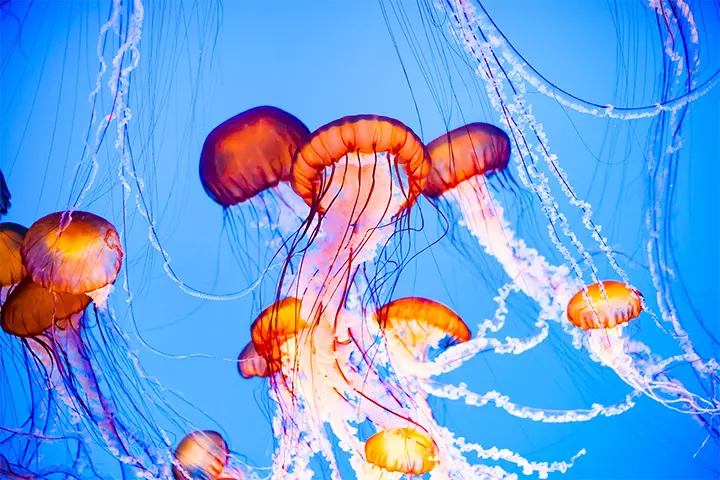
When the conditions are good, that is the perfect temperature and plenty of food, jellyfish can grow extremely fast and reach high numbers. It’s a part of the natural seasonal cycle of the jellyfish species.
But scientists also believe that we have more jellyfish than before because of the changes brought in the ocean. A combination of climate change, overfishing, nutrients, and the introduction of species could also be why jellyfish numbers have skyrocketed. Some scientists also say that jellyfish have increased because of coastal development, providing more underwater habitat for the jellyfish to grow.
11. What do the jellyfish eat?
Jellyfish’s diet consists of different things like fish eggs, copepodsiA group of small aquatic crustaceans found in freshwater and marine environments , shrimps, small plants, and other small fish called larvae. They eat the planktonic eggs at the younger stages. Some jellyfish also eat other jellyfish! When the jellyfish bloom, they eat almost everything in the water, which often causes problems for the fisheries because of the lack of food.
Jellyfish have a strong digestive system. They digest the food extremely fast. That’s because they wouldn’t be able to float if they carried digested meals around.
12. The friendliest jellyfish
Moon Jellyfish is the friendliest species of jellyfish. These jellyfish also sting, but the effects are mild and short-term.
Moon Jellyfish is the most common species of jellyfish. You’ll find this species of jellyfish mostly in the aquariums. But since they are a minuscule species of jellyfish, they do not survive for more than six months in their natural habitat. The factors responsible for the death of Moon Jellyfish are warm temperature, lack of food and diseases. They live for several years in the controlled conditions of the aquariums, where there is no predator or competition for food.
13. Jellyfish as food
Non-poisonous jellyfish are considered a delicacy in many parts of the world. Around several hundred metric tons of jellyfish are eaten every year at $15 a pound, making it a multi-million dollar business. The Cannonball Jellyfish is the most commonly eaten jellyfish.
After being caught, a treatment procedure is continued for 20 to 40 days, during which the gonads and mucus lining are removed. The remaining edible parts are processed with an alum and salt mixture. The result is crunchy and salty jellies.
The Chinese have been fishing it for over 17000 years for food and in Malaysia, people call them “music to the teeth.”
A group of students in Japan made a salted caramel dish using powdered jellyfish. Scientists say that it’s an excellent way to deal with the Jellyfish Bloom.
 Quick fact
Quick fact14. Jellyfish are great at shutting down nuclear reactors
It has been reported that jellyfish blooms are responsible for shutting down nuclear reactors, most of which rely on ocean water intake. Swarms of jellyfish clog intake pipes, forcing many facilities to cease operations temporarily.
15. The life cycle of a jellyfish
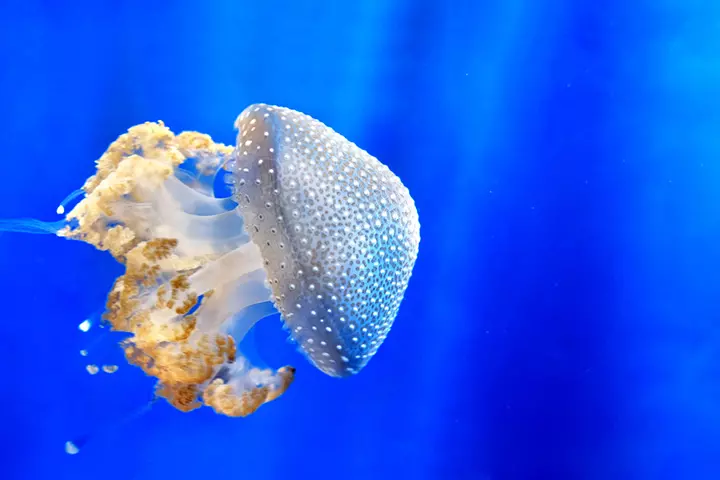
Just like most animals, even the jellyfish has a life cycle. Their reproduction process is known as the medusa stage where jellies swim around with their tentacles hanging down. Male and female medusa then reproduce and form thousands of tiny larvae called planulae. The larvae settle on the bottom of the ocean and form small polyps that look just like little small Anemone. When the water temperature reaches around 62°F in the spring, the polyps start to develop and stretch into a series of small jellyfish clones, forming a chain or stack known as a strobila (3). The polyp buds off baby jellyfish called the ephyrae, which grow quickly into adult medusa.
16. Lifespan of a jellyfish
The lifespan of jellies is 30 years. Some jellyfish live less than a year while the smallest one lives just for a few hours. The size and lifespan depend on the species. But on an average, most jellyfish live for 2 to 6 months.
 Did you know?
Did you know?17. Some jellyfish glow in the dark
Around 50% of jellyfish have the quality of bioluminescence, which means they make their light. They have bioluminescent organs that help them emit light. These jellies use this light to distract predators and attract prey. For example, comb jellies flash bright lights to confuse predators, while others release glowing tentacles or particles to create a distraction (2).
18. Jellyfish are not good swimmers
With no flippers or fins, jellyfish are weak swimmers. They swim by contracting the muscles at the bottom of their belly.
The upside-down jellyfish do not even float in the waters. Instead, they bring themselves to the ocean floor using their short arms and tentacles. They look more like a bowl of plants than typical jellyfish.
19. Intelligent attackers
Jellies do not chase or stalk their prey. Instead, they swim or drift with the tentacles dangling behind them. If a fish or other small creatures bump into the tentacles, it is zapped by the stingers. Then they use the oral arms to move the prey to the mouth.
20. The secret weapon
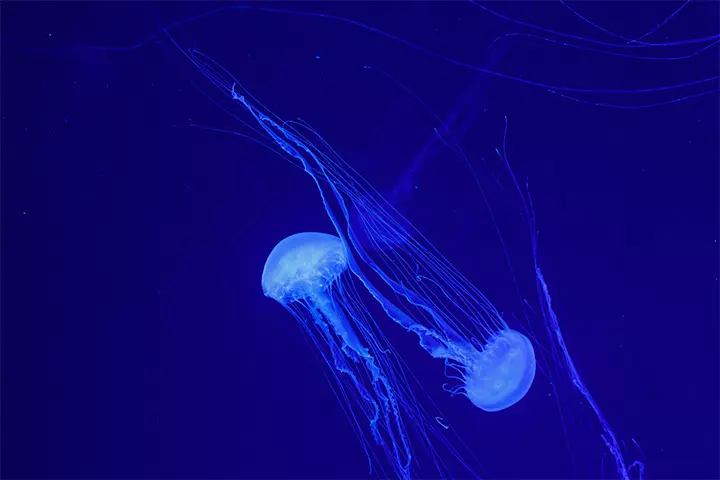
Along with the tentacles, jellies also have a secret weapon, that’s their oral arms and their tiny stinging cells called nematocysts. These cells contain little harpoons full of venom, which can do away with or stun the prey.
21. Not all jellies are loners
Though most animals avoid jellies, some like hanging around with them. A few marine creatures use jellyfish as a kind of bodyguard. For instance, crabs are known to hitchhike on jellyfish. Some tag along for a ride inside its belly or just stay close to the jelly. There are different ideas why the tagalongs are unharmed by the jellies. Some researchers say that these tagalongs cover themselves with mucus to keep the stingers from firing. Or maybe they are just too careful not to touch the jelly’s tentacles.
22. Jellyfish clone themselves
If you cut a jellyfish in two, these two pieces can regenerate and create two new organisms. It can clone itself, even when it is injured, thereby producing hundreds of offspring.
23. Jellyfish teach us about efficient underwater propulsion
The movement of the bell-shaped jellyfish has given researchers an understanding of propulsion. The flexibility of their umbrella-shaped bodies allows the jellyfish to move upwards and downwards without expending too much energy. Researchers have created a biomimeticiThe designing of technology and materials that mimic natural systems, structures, and processes in living organisms for study purposes robot with flexible bells, which can lead to better undersea vehicles.
24. Some species jellyfish are immortal
There are two stages in the life of a jellyfish- the mobile medusa phase and stationary polyp stage. They earned the nickname ‘immortal jellyfish’ for its ability to travel to the polyp stage in times of stress.
25. Aggressive colonizers
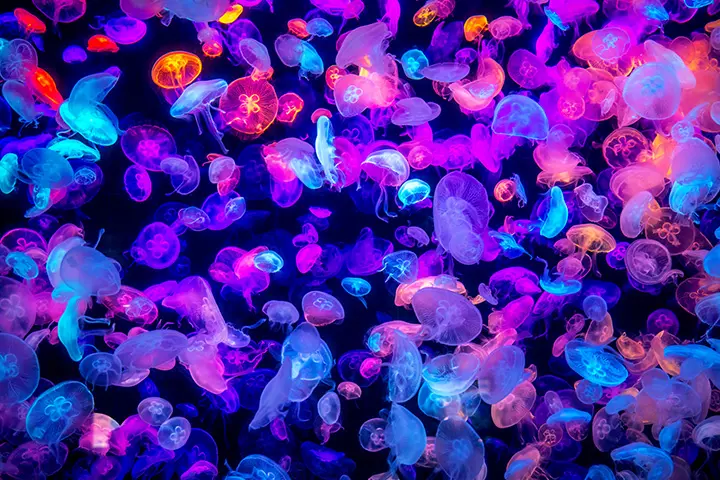
Jellyfish are very aggressive colonizers. When the Comb Jellies were introduced into the Black Sea in the year 1982, they totaled 900 million tons. Eight years after the introduction, they caused $350 million in losses to the Black Sea’s tourism and fishing industries
26. Jellyfish also sleep but differently
Jellyfish may not sleep the way humans do. But according to a study, they do rest at night. The researcher observed a jellyfish and noted that it was relatively inactive at night as its heart pulsed only 39 times per minute, whereas, during a normal daytime, it would pulse around 58 times per minute. As soon as the researchers would find its pulse dropping, they would cause a sudden movement in the water to see its reaction. They noted that in normal circumstances it would react quickly, but in its nightly resting state it would float in water for a while before becoming aware of the movement in its surroundings (4).
Types Of Jellyfish
Jellyfish is the common name used to describe adult Medusozoa, a sub-group of the Cnidaria phylum. While there are over 4,000 species of jellyfish or Medusozoa, they can be divided into four distinct categories:
- Scyphozoa: These are the most popular varieties of jellyfish, often known for their colorful bodies and interaction with humans. Because of this, Scyphozoa are known as “true jellyfish.”
- Cubozoa: These jellyfish are known for their box-shaped bells. They produce extremely potent venom and have a more developed nervous system than most other jellyfish, along with a complex ocular system.
- Staurozoa: A unique sub-type of jellyfish, Staurozoa are funnel-shaped and do not float or swim like other jellyfish. They remain attached to rocks or seaweed and are known for their ability to camouflage themselves.
- Hydrozoa: Hydrozoans make up the largest sub-group of jellyfish, with around 3,800 species. Some are small and barely visible in the swimming stage, and most of them take the form of large colonies at the bottom of the ocean.
Fun Jellyfish Facts For Kids
- A group of jellyfish is called smack or bloom. A smack or bloom of jellyfish can consist of more than 100,000 jellyfish.
- You must have noticed that jellyfish are mostly kept in round aquariums. That’s because round aquariums prevent them from getting stuck in the corners.
- If someone is stung by the jellyfish, pour vinegar over the wound and seek medical assistance as soon as possible.
 Did you know?
Did you know?- The movements of jellyfish inspired a flying machine at the New York University.
- Jellies’ fluorescent protein can be used to make power medical devices in the future.
- Common predators of the jellyfish are tuna, sharks, jellyfish, sea turtles, swordfish, and Pacific salmon.
- Jellyfish blooms near Japan can have around 500 million jellyfish, with each jelly the size of a refrigerator.
- Jellyfish account for over ten times the weight of the annual fishes caught around the world.
- Jellies have medicinal value too. They are harvested for collageniProtein that provides structural support and elasticity to connective tissues with its fiber-like structure that is used in plenty of ways, including the treatment of rheumatoid arthritisiAn autoimmune disease that causes chronic inflammation of joints, causing pain and stiffness .
- Approximately, 160 million people are exposed to jellyfish annually all across the globe. And around 500,000 people in the Chesapeake Bay and 200,000 in Florida are stung each year.
- World Jellyfish Day is observed on November 3rd to celebrate these fascinating creatures that have roamed the oceans for millions of years. Established in 2014, the day also promotes awareness and conservation initiatives for jellyfish (5).
The Ecological Role Of Jellyfish
Jellyfish play a vital role in marine ecosystems and beyond. They contribute to the balance of oceanic food chains and offer the potential for groundbreaking scientific advancements. Here are its roles and significance in the ecosystem (5) (6):
- Mutualistic relationships: Jellyfish provide shelter and protection to various fish species, who also help clean the jellyfish by removing parasites and debris.
- Ecosystem balance: By preying on smaller creatures and even other jellyfish, jellyfish help regulate populations and maintain marine ecosystem balance.
- Nutrient recycling: Jellyfish contribute to the ocean’s nutrient cycle, transporting essential elements like nitrogen and phosphorus, which support the growth of phytoplankton.
- Scientific potential: Jellyfish have shown promise in medical research, including cancer cell inhibition and aiding space travel research, thanks to their unique abilities and adaptability.
- Food chain importance: Jellyfish help control populations of smaller marine life, contributing to the stability of the ocean food web.
Jellyfish are not just passive organisms drifting through the ocean—they play an integral part in maintaining ecological balance, supporting marine life, and holding significant potential for human scientific progress.
Frequently Asked Questions
1. Can jellyfish hear?
Jellyfish do not have ears and do not have a true hearing ability (7). However, jellyfish can detect underwater sounds and respond to them with the help of tiny hair-like sensors on their body (8).
2. How many hearts does a jellyfish have?
Jellyfish do not have hearts (9). The reason is that they do not have a circulatory system. The nutrients, gasses, and wastes are exchanged with the ambient water through diffusion (10).
3. Can jellyfish survive without food?
Jellyfish may shrink themselves to survive for longer without food. Those living in natural habitats seldom have food shortages since jellyfish have a wide appetite. They can eat almost anything, from tiny plankton to fish and even other jellyfish (11).
4. What is the ecological role of jellyfish?
Jellyfish are an important part of marine ecosystems and food chains as they serve as both predators (for small fish, fish eggs, and zooplankton) and prey (for large fish, turtles, whales, and seabirds). They also play a role in nutrient cycling, particularly nitrogen and phosphorous, in the sea.
5. What should I do if I get stung by a jellyfish?
When stung by a jellyfish, rinse the area immediately with seawater, not fresh water. If the tentacles are still attached, do not touch them. Instead, remove them with a pair of tweezers or a dry towel. Soak the injured area in warm water, as hot as you can stand, for at least half an hour. Take care not to ice the wound or cover it. If the pain persists, consider over-the-counter painkillers like paracetamol or ibuprofen, but if the situation seems severe, head to your nearest emergency room or minor injuries unit for medical attention (12).
Knowing some facts about jellyfish for kids can be exciting since they are beautiful marine creatures. You may explain the scientific classification of jellyfish and their anatomy to your children. Jellyfish are not real fish and have deadly tentacles filled with toxins that can be injected while stinging. They move according to the tide of wind and water, and some may glow in the dark. Non-poisonous jellyfish are consumed in many parts of the world. Climate change and ocean changes increase the number of jellyfish, and these facts will get your child interested to know more about marine life. You can also introduce them to more water animal information for kids to broaden their understanding of marine creatures and their habitats.
Infographic: Fun Jellyfish Facts
Jellyfish are known to be among the captivating ocean-dwelling creatures. Although they may be seen in various shapes, jellyfishes have a characteristic umbrella-shaped bell and trailing tentacles. Scour through the infographic below for more exciting information about jellyfish; share them with your little ones to enhance their interest in these aquatic wonders. Illustration: Momjunction Design Team
Illustration: Fun Facts And Information About Jellyfish For Kids
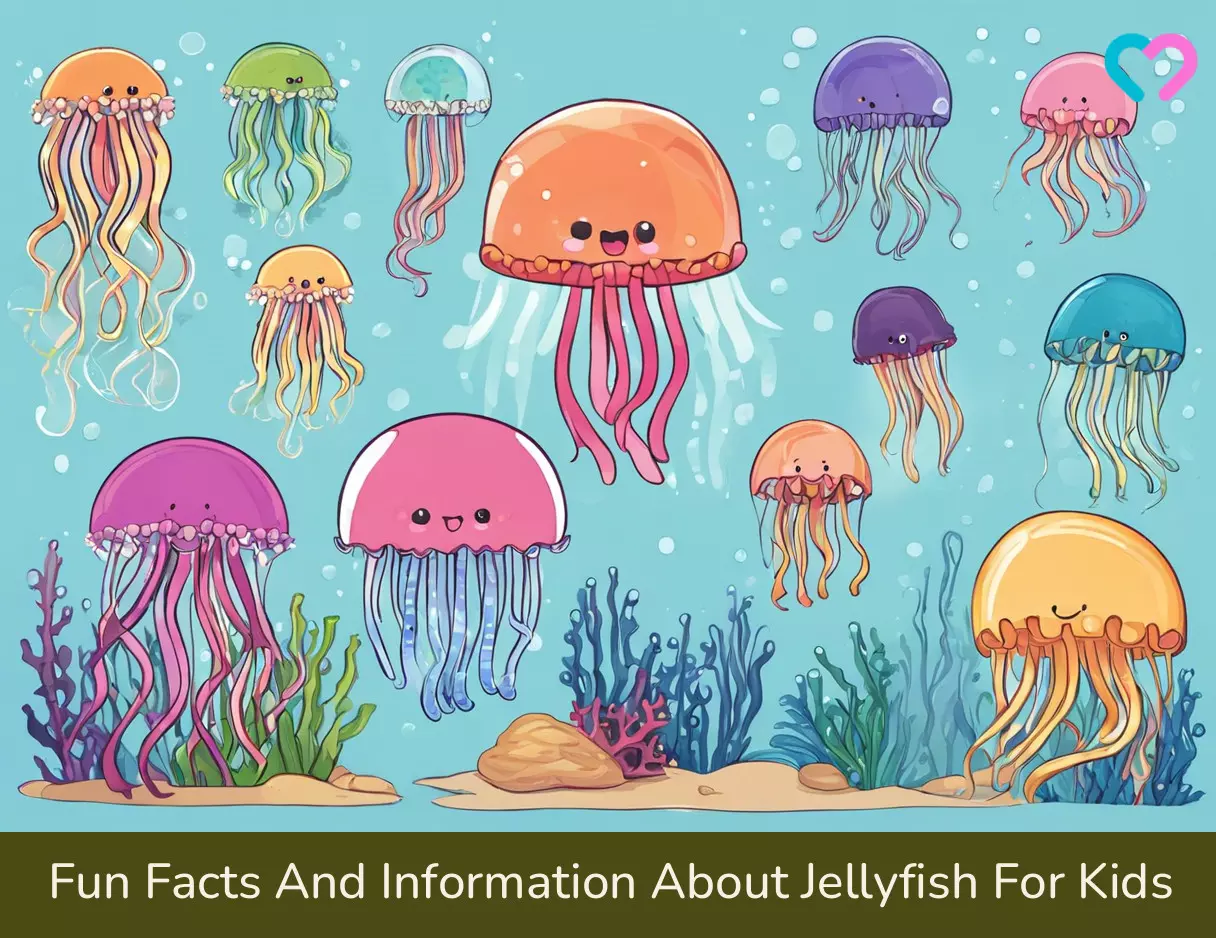
Image: Stable Diffusion/MomJunction Design Team
Learn all about jellyfish with this fun and educational video! Discover their anatomy, behavior, and more as we explore the fascinating world of jellyfish!
References
- Five jaw-dropping facts about jellyfish.
https://www.oneearth.org/five-jaw-dropping-facts-about-jellyfish/ - Celebrate National Jellyfish Day With These 9 Amazing Jellyfish Facts!
https://www.peta.org/features/fascinating-facts-about-jellyfish/ - Life Cycle of Jellyfish.
https://www.vims.edu/bayinfo/jellyfish/lifecycle/ - The Surprising Ancient Behavior of Jellyfish.
https://www.caltech.edu/about/news/surprising-ancient-behavior-jellyfish-79701 - World Jellyfish Day 2024: Celebrating the Graceful Drifters of the Ocean.
https://earth.org/world-jellyfish-day-2024-celebrating-the-graceful-drifters-of-the-ocean/ - Jellyfish: Helping to keep our ocean full of life.
https://www.mcsuk.org/news/jellyfish-helping-to-keep-our-ocean-full-of-life/#:~:text=Jellyfish%20are%20an%20essential%20part - A stress test for jellyfish.
https://wyss.harvard.edu/news/a-stress-test-for-jellyfish/ - David J. Albert; (2010); What’s on the mind of a jellyfish? A review of behavioural observations on Aurelia sp. Jellyfish.
http://www.rctn.org/bruno/animal-eyes/jellyfish-papers/Neuroscience%20and%20Biobehavioral%20Reviews%202011%20Albert.pdf - Hearts and the Heartless in the Animal Kingdom.
https://kids.frontiersin.org/articles/10.3389/frym.2020.540440 - Overview of the Circulatory System.
https://opened.cuny.edu/courseware/lesson/813/student/?task=3 - Jellyfish And Comb Jellies.
https://ocean.si.edu/ocean-life/invertebrates/jellyfish-and-comb-jellies - Jellyfish and other sea creature stings.
https://www.nhs.uk/conditions/jellyfish-and-other-sea-creature-stings/ - Intra and Inter specific variation in edible jellyfish Biomarkers and implications for origin Traceability and authentication.
https://www.frontiersin.org/journals/marine-science/articles/10.3389/fmars.2021.755048/full - How to Treat and Prevent Jellyfish Stings.
https://www.chkd.org/blog/how-to-treat-and-prevent-jellyfish-stings/
Community Experiences
Join the conversation and become a part of our nurturing community! Share your stories, experiences, and insights to connect with fellow parents.
Read full bio of Elisa Yi
Read full bio of Manjiri Kochrekar
Read full bio of Harshita Makvana
Read full bio of Trisha Chakraborty








